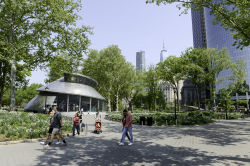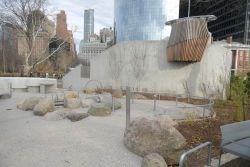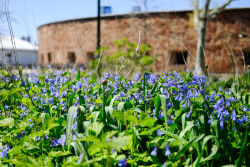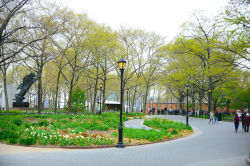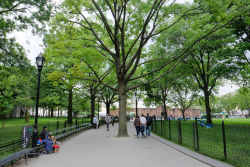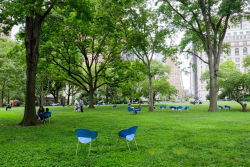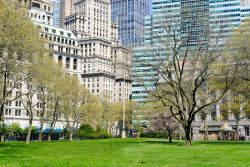The Battery
The Daily Plant : Thursday, December 13, 2001
"THE BATTERY IS COMING BACK!"
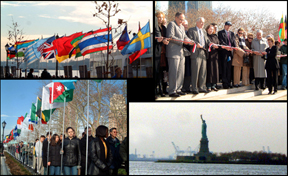
Discovery. Settlement. Defense. Commerce. Leisure. Every strand of our civic life has been woven into the history of Battery Park. There the modern history of New York City began. Four million people visit Battery Park each year. This year, Parks and the Conservancy for Historic Battery Park undertook a renovation of one of the park’s most defining features, the promenade. On the three-month anniversary of the September 11 attacks, New Yorkers returned to the place where rescue workers gathered and the ferry landing from which civilians fled.
Mayor Rudolph (Eagle) Giuliani; Council Member Kathryn (Punster) Freed; Commissioner Henry J. (StarQuest) Stern; Major General John P. Herrling, Retired Secretary of the American Battle Monuments Commission; William (Cyberblade) Rudin, Chair of the Conservancy for Historic Battery Park; and Warrie (Whirlybird) Price, President of the Conservancy for Historic Battery Park delivered speeches to mark the reopening of the Upper Promenade and the rededication of the East Coast Memorial.
Today, visitors may walk the length of the promenade from Pier A to the Whitehall Ferry Terminal, enjoying an uninterrupted view out to the Hudson River’s expanse and into the thicket of lower Manhattan through a frame of flowering trees and historic monuments. Nearly 10,000 square feet of gardens trace the island’s edge. Planted with 40,000 orange tulips, 10,000 daffodils, and 24 swamp oak trees, the gardens will bloom next spring, and every spring thereafter, in tribute to the victims of the September 11 attacks. In accordance with the redesign, six grand stairways lead directly to the foot of Battery Park’s six ferry gangways. The pavings are now safer and the park’s twenty-three acres brilliantly lit with energy efficient lights. A long granite bench follows the shape of the land. An ideal seat from which to view the horizon, the new bench is of the same hue as a New York sky at sunset.
As part of the redesign, three of the park’s historic monuments, the Norwegian Maritime Monument, the George Dewey Monument, and the Emma Lazarus Monument, were moved to prominent positions within the park. The East Coast Memorial to World War II was reconfigured, its stairway and balustrade rebuilt. The monument, which was originally commissioned by the American Battle Monuments Commission (ABMC) and dedicated by President John F. Kennedy on May 23, 1963, was improved with funds from the ABMC and support from Parks and the Conservancy for Historic Battery Park. In this monumental work, which stands in full view of the water, 8 towering tablets record the names of the 4,601 American servicemen who died in the Atlantic Ocean. At the center of the arrangement, a bronze eagle perches at the edge of a laurel wreath that floats on the crest of a wave. This is the symbol for mourning at a watery grave.
The promenade was reconstructed with $6.6 million, a combination of public and private funds. Mayor Giuliani dedicated $5 million. Council Member Kathryn Freed allocated $500,000, and grants from New York State provided an additional $754,000. Private funders, led by the Alliance for Downtown New York, contributed their advocacy as well as a total of $272,500. This range of supporters testifies to the breadth of the park’s influence.
In the hours and days following the collapse of the World Trade Center, New Yorkers met in Battery Park to make first phone calls and later memorials. Between 300 and 400 National Guardsmen camped on the grounds of Battery Park. Mobile command centers were stationed at every entrance, and tugboats carried rescue workers to and from lower Manhattan. On December 11, under the gaze of the Statue of Liberty, students from Stuyvesant High School planted 82 flags in the soil as a gesture of solidarity with the international communities that suffered as a result of the attacks, and Warrie Price declared to the crowd, "the Battery is coming back".
For generations of families, Battery Park has represented a beginning. New Yorkers returned to Battery Park on that day to renew their spirits and the spirit of the city.
Read the historic sign for Battery Park.
THIRTEEN YEARS AGO IN THE PLANT
(Thursday, December 22, 1988)
THE YEAR IN REVIEW: CITYWIDE SERVICES 1988
In 1988 Citywide Services kept the giant greening machine of Parks running smoothly from planting trees, fabricating basketball hoops and repairing Parks vehicles to maintaining pools, patrolling parks and leading educational walks in all five boroughs.
In May Five-Borough Shops moved to new headquarters on Randall’s Island—a two-acre, $10 million garage complete with state-of-the-art equipment such as power truck lifts and a hydraulic pressure test bench. The new FAMIS (Fleet and Maintenance Installation System) computer system was completed in February to track maintenance, repairs and parts for Parks’ 1,600 vehicles.
QUOTATION FOR THE DAY
"From her beacon-hand
Glows world-wide welcome, her mild eyes command
The air-bridged harbor that twin cities frame."
Emma Lazarus (1849-1887)




